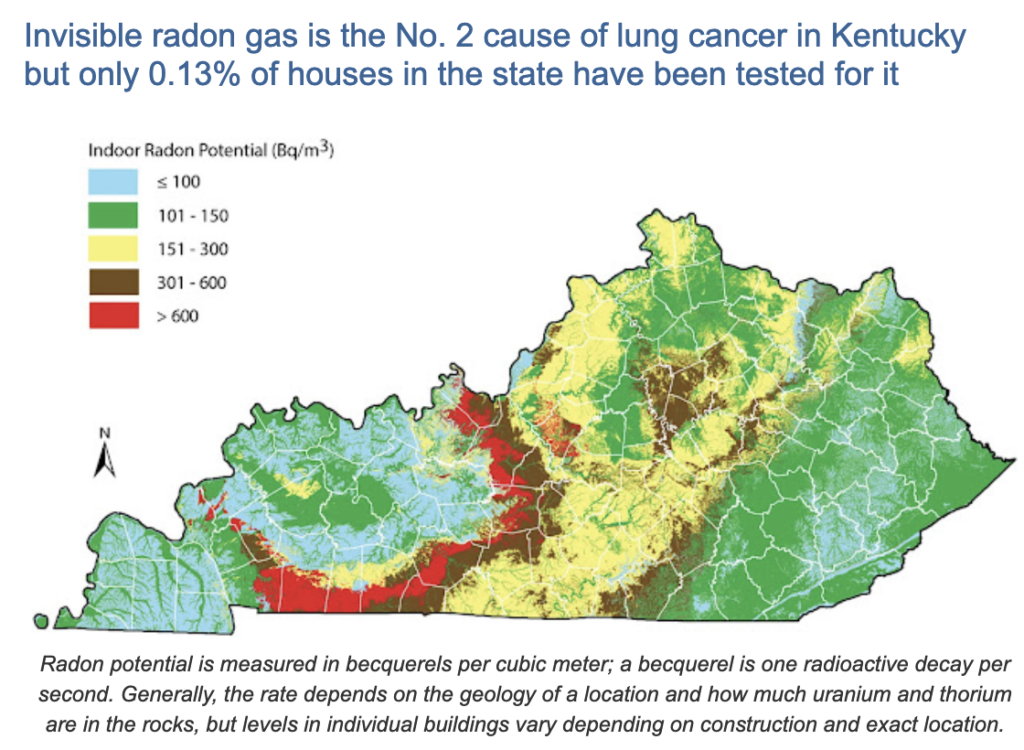Invisible radon gas is the No. 2 cause of lung cancer in Kentucky but only 0.13% of houses in the state have been tested for it

Three of every seven buildings in Kentucky have elevated levels of a colorless, odorless gas that is a significant cause of lung cancer, reports Bill Estep of the Lexington Herald-Leader. That rate of 42% is six times the national rate of 7%, according to the Kentucky Association of Radon Professionals.
But only 13 of every 10,000 houses in Kentucky have been tested for radon, says Ellen Hahn, a professor in the University of Kentucky nursing professor who runs BREATHE, which stands for for Bridging Research Efforts and Advocacy Toward Healthier Environments.
 Kentucky has the nation’s highest age-adjusted rate of lung cancer, mainly because it has the nation’s second-highest smoking rate, but some people who have never smoked or have little exposure to indoor tobacco smoke get lung cancer. Radon is the No. 2 cause of lung cancer, and a combination of radon and smoking create an even higher risk of the disease, Estep reports.
Kentucky has the nation’s highest age-adjusted rate of lung cancer, mainly because it has the nation’s second-highest smoking rate, but some people who have never smoked or have little exposure to indoor tobacco smoke get lung cancer. Radon is the No. 2 cause of lung cancer, and a combination of radon and smoking create an even higher risk of the disease, Estep reports.
“Lindi Campbell, 58, was fit, active and had never smoked, but had to have two lobes of her right lung removed in December 2017 as a result of developing lung cancer. Campbell said she grew up in Lexington in a house where she was exposed to secondhand cigarette smoke and radon,” Estep reports. “After she was diagnosed with cancer, she had her childhood home tested. The results showed a radon level that was the equivalent of smoking 40 cigarettes a day, she said.”
Campbell is president of Breath of Hope KY, which tries to raise awareness about lung cancer, reduce stigma surrounding it, and raise money for research.
Radon is a product of the natural decay of uranium and thorium, another radioactive element. “As it breaks down, it releases radioactive particles that can be inhaled and damage lung tissue over time,” Estep notes. Newer homes are more likely to have a buildup because are more tightly sealed.
Estep offers ways to take action to protect yourself: “Radon information is available through several sources, including BREATHE; the Kentucky Geological Survey; the Kentucky Radon Program; the U.S. Environmental Protection Agency; and the American Lung Association. Health officials also recommend testing your home.”
“Everyone needs to test,” Hahn said. “There’s no risk-free level of radon.”
And how much do those systems cost? “Tracy Howard said it cost $1,300 to have Alpha Radon Remediation install an exhaust system in the basement of her house in Stanford on May 24,” Estep writes. “Howard got a free test kit from the local health department and the results showed a radon level of 4.2, just over the limit at which the EPA recommends installing a system to reduce the radon level. Howard, a nurse who works from home to do remote patient monitoring, shares the house with her husband and their daughter and 4-year-old grandson. She wanted to reduce their risk of exposure to the cancer-causing substance. To her, it was worth $1,300 to accomplish that.”
“I know how dangerous it is,” Howard told Estep. “Consider the cost of installing the system vs. the cost of getting lung cancer later in life.”